| Listing 1 - 10 of 13 | << page >> |
Sort by
|
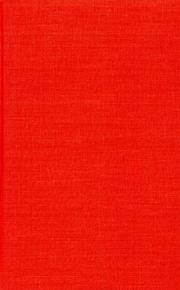
ISBN: 0691085773 1306986230 0691602891 0691632340 1400861063 9780691085777 Year: 1990 Volume: 39 Publisher: Princeton, N.J. Princeton University Press
Abstract | Keywords | Export | Availability | Bookmark
 Loading...
Loading...Choose an application
- Reference Manager
- EndNote
- RefWorks (Direct export to RefWorks)
One of the great achievements of contemporary mathematics is the new understanding of four dimensions. Michael Freedman and Frank Quinn have been the principals in the geometric and topological development of this subject, proving the Poincar and Annulus conjectures respectively. Recognition for this work includes the award of the Fields Medal of the International Congress of Mathematicians to Freedman in 1986. In Topology of 4-Manifolds these authors have collaborated to give a complete and accessible account of the current state of knowledge in this field. The basic material has been considerably simplified from the original publications, and should be accessible to most graduate students. The advanced material goes well beyond the literature; nearly one-third of the book is new. This work is indispensable for any topologist whose work includes four dimensions. It is a valuable reference for geometers and physicists who need an awareness of the topological side of the field.Originally published in 1990.The Princeton Legacy Library uses the latest print-on-demand technology to again make available previously out-of-print books from the distinguished backlist of Princeton University Press. These editions preserve the original texts of these important books while presenting them in durable paperback and hardcover editions. The goal of the Princeton Legacy Library is to vastly increase access to the rich scholarly heritage found in the thousands of books published by Princeton University Press since its founding in 1905.
Differential topology --- Four-manifolds (Topology) --- Trois-variétés (Topologie) --- Vier-menigvuldigheden (Topologie) --- 4-dimensional manifolds (Topology) --- 4-manifolds (Topology) --- Four dimensional manifolds (Topology) --- Manifolds, Four dimensional --- Low-dimensional topology --- Topological manifolds --- 4-manifold. --- Ambient isotopy. --- Annulus theorem. --- Automorphism. --- Baire category theorem. --- Bilinear form. --- Boundary (topology). --- CW complex. --- Category of manifolds. --- Central series. --- Characterization (mathematics). --- Cohomology. --- Commutative diagram. --- Commutative property. --- Commutator subgroup. --- Compactification (mathematics). --- Conformal geometry. --- Connected sum. --- Connectivity (graph theory). --- Cyclic group. --- Diagram (category theory). --- Diameter. --- Diffeomorphism. --- Differentiable manifold. --- Differential geometry. --- Dimension. --- Disk (mathematics). --- Duality (mathematics). --- Eigenvalues and eigenvectors. --- Embedding problem. --- Embedding. --- Equivariant map. --- Fiber bundle. --- Four-dimensional space. --- Fundamental group. --- General position. --- Geometry. --- H-cobordism. --- Handlebody. --- Hauptvermutung. --- Homeomorphism. --- Homology (mathematics). --- Homology sphere. --- Homomorphism. --- Homotopy group. --- Homotopy sphere. --- Homotopy. --- Hurewicz theorem. --- Hyperbolic geometry. --- Hyperbolic group. --- Hyperbolic manifold. --- Identity matrix. --- Intermediate value theorem. --- Intersection (set theory). --- Intersection curve. --- Intersection form (4-manifold). --- Intersection number (graph theory). --- Intersection number. --- J-homomorphism. --- Knot theory. --- Lefschetz duality. --- Line–line intersection. --- Manifold. --- Mapping cylinder. --- Mathematical induction. --- Metric space. --- Metrization theorem. --- Module (mathematics). --- Normal bundle. --- Parametrization. --- Parity (mathematics). --- Product topology. --- Pullback (differential geometry). --- Regular homotopy. --- Ring homomorphism. --- Rotation number. --- Seifert–van Kampen theorem. --- Sesquilinear form. --- Set (mathematics). --- Simply connected space. --- Smooth structure. --- Special case. --- Spin structure. --- Submanifold. --- Subset. --- Support (mathematics). --- Tangent bundle. --- Tangent space. --- Tensor product. --- Theorem. --- Topological category. --- Topological manifold. --- Transversal (geometry). --- Transversality (mathematics). --- Transversality theorem. --- Uniqueness theorem. --- Unit disk. --- Vector bundle. --- Whitehead torsion. --- Whitney disk.
Book
Year: 2020 Publisher: Basel, Switzerland MDPI - Multidisciplinary Digital Publishing Institute
Abstract | Keywords | Export | Availability | Bookmark
 Loading...
Loading...Choose an application
- Reference Manager
- EndNote
- RefWorks (Direct export to RefWorks)
According to Carl Friedrich Gauss (1777–1855), mathematics is the queen of the sciences—and number theory is the queen of mathematics. Numbers (integers, algebraic integers, transcendental numbers, p-adic numbers) and symmetries are investigated in the nine refereed papers of this MDPI issue. This book shows how symmetry pervades number theory. In particular, it highlights connections between symmetry and number theory, quantum computing and elementary particles (thanks to 3-manifolds), and other branches of mathematics (such as probability spaces) and revisits standard subjects (such as the Sieve procedure, primality tests, and Pascal’s triangle). The book should be of interest to all mathematicians, and physicists.
Research & information: general --- Mathematics & science --- quantum computation --- IC-POVMs --- knot theory --- three-manifolds --- branch coverings --- Dehn surgeries --- zeta function --- Pólya-Hilbert conjecture --- Riemann interferometer --- prime numbers --- Prime Number Theorem (P.N.T.) --- modified Sieve procedure --- binary periodical sequences --- prime number function --- prime characteristic function --- limited intervals --- logarithmic integral estimations --- twin prime numbers --- free probability --- p-adic number fields ℚp --- Banach ∗-probability spaces --- C*-algebras --- semicircular elements --- the semicircular law --- asymptotic semicircular laws --- Kaprekar constants --- Kaprekar transformation --- fixed points for recursive functions --- Baker’s theorem --- Gel’fond–Schneider theorem --- algebraic number --- transcendental number --- standard model of elementary particles --- 4-manifold topology --- particles as 3-Braids --- branched coverings --- knots and links --- charge as Hirzebruch defect --- umbral moonshine --- number of generations --- the pe-Pascal’s triangle --- Lucas’ result on the Pascal’s triangle --- congruences of binomial expansions --- primality test --- Miller–Rabin primality test --- strong pseudoprimes --- primality witnesses
Book
Year: 2020 Publisher: Basel, Switzerland MDPI - Multidisciplinary Digital Publishing Institute
Abstract | Keywords | Export | Availability | Bookmark
 Loading...
Loading...Choose an application
- Reference Manager
- EndNote
- RefWorks (Direct export to RefWorks)
According to Carl Friedrich Gauss (1777–1855), mathematics is the queen of the sciences—and number theory is the queen of mathematics. Numbers (integers, algebraic integers, transcendental numbers, p-adic numbers) and symmetries are investigated in the nine refereed papers of this MDPI issue. This book shows how symmetry pervades number theory. In particular, it highlights connections between symmetry and number theory, quantum computing and elementary particles (thanks to 3-manifolds), and other branches of mathematics (such as probability spaces) and revisits standard subjects (such as the Sieve procedure, primality tests, and Pascal’s triangle). The book should be of interest to all mathematicians, and physicists.
quantum computation --- IC-POVMs --- knot theory --- three-manifolds --- branch coverings --- Dehn surgeries --- zeta function --- Pólya-Hilbert conjecture --- Riemann interferometer --- prime numbers --- Prime Number Theorem (P.N.T.) --- modified Sieve procedure --- binary periodical sequences --- prime number function --- prime characteristic function --- limited intervals --- logarithmic integral estimations --- twin prime numbers --- free probability --- p-adic number fields ℚp --- Banach ∗-probability spaces --- C*-algebras --- semicircular elements --- the semicircular law --- asymptotic semicircular laws --- Kaprekar constants --- Kaprekar transformation --- fixed points for recursive functions --- Baker’s theorem --- Gel’fond–Schneider theorem --- algebraic number --- transcendental number --- standard model of elementary particles --- 4-manifold topology --- particles as 3-Braids --- branched coverings --- knots and links --- charge as Hirzebruch defect --- umbral moonshine --- number of generations --- the pe-Pascal’s triangle --- Lucas’ result on the Pascal’s triangle --- congruences of binomial expansions --- primality test --- Miller–Rabin primality test --- strong pseudoprimes --- primality witnesses
Book
Year: 2020 Publisher: Basel, Switzerland MDPI - Multidisciplinary Digital Publishing Institute
Abstract | Keywords | Export | Availability | Bookmark
 Loading...
Loading...Choose an application
- Reference Manager
- EndNote
- RefWorks (Direct export to RefWorks)
According to Carl Friedrich Gauss (1777–1855), mathematics is the queen of the sciences—and number theory is the queen of mathematics. Numbers (integers, algebraic integers, transcendental numbers, p-adic numbers) and symmetries are investigated in the nine refereed papers of this MDPI issue. This book shows how symmetry pervades number theory. In particular, it highlights connections between symmetry and number theory, quantum computing and elementary particles (thanks to 3-manifolds), and other branches of mathematics (such as probability spaces) and revisits standard subjects (such as the Sieve procedure, primality tests, and Pascal’s triangle). The book should be of interest to all mathematicians, and physicists.
Research & information: general --- Mathematics & science --- quantum computation --- IC-POVMs --- knot theory --- three-manifolds --- branch coverings --- Dehn surgeries --- zeta function --- Pólya-Hilbert conjecture --- Riemann interferometer --- prime numbers --- Prime Number Theorem (P.N.T.) --- modified Sieve procedure --- binary periodical sequences --- prime number function --- prime characteristic function --- limited intervals --- logarithmic integral estimations --- twin prime numbers --- free probability --- p-adic number fields ℚp --- Banach ∗-probability spaces --- C*-algebras --- semicircular elements --- the semicircular law --- asymptotic semicircular laws --- Kaprekar constants --- Kaprekar transformation --- fixed points for recursive functions --- Baker’s theorem --- Gel’fond–Schneider theorem --- algebraic number --- transcendental number --- standard model of elementary particles --- 4-manifold topology --- particles as 3-Braids --- branched coverings --- knots and links --- charge as Hirzebruch defect --- umbral moonshine --- number of generations --- the pe-Pascal’s triangle --- Lucas’ result on the Pascal’s triangle --- congruences of binomial expansions --- primality test --- Miller–Rabin primality test --- strong pseudoprimes --- primality witnesses --- quantum computation --- IC-POVMs --- knot theory --- three-manifolds --- branch coverings --- Dehn surgeries --- zeta function --- Pólya-Hilbert conjecture --- Riemann interferometer --- prime numbers --- Prime Number Theorem (P.N.T.) --- modified Sieve procedure --- binary periodical sequences --- prime number function --- prime characteristic function --- limited intervals --- logarithmic integral estimations --- twin prime numbers --- free probability --- p-adic number fields ℚp --- Banach ∗-probability spaces --- C*-algebras --- semicircular elements --- the semicircular law --- asymptotic semicircular laws --- Kaprekar constants --- Kaprekar transformation --- fixed points for recursive functions --- Baker’s theorem --- Gel’fond–Schneider theorem --- algebraic number --- transcendental number --- standard model of elementary particles --- 4-manifold topology --- particles as 3-Braids --- branched coverings --- knots and links --- charge as Hirzebruch defect --- umbral moonshine --- number of generations --- the pe-Pascal’s triangle --- Lucas’ result on the Pascal’s triangle --- congruences of binomial expansions --- primality test --- Miller–Rabin primality test --- strong pseudoprimes --- primality witnesses
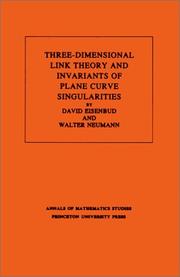
ISBN: 0691083819 0691083800 1400881927 9780691083810 9780691083803 Year: 1985 Volume: 110 Publisher: Princeton Princeton University Press
Abstract | Keywords | Export | Availability | Bookmark
 Loading...
Loading...Choose an application
- Reference Manager
- EndNote
- RefWorks (Direct export to RefWorks)
This book gives a new foundation for the theory of links in 3-space modeled on the modern developmentby Jaco, Shalen, Johannson, Thurston et al. of the theory of 3-manifolds. The basic construction is a method of obtaining any link by "splicing" links of the simplest kinds, namely those whose exteriors are Seifert fibered or hyperbolic. This approach to link theory is particularly attractive since most invariants of links are additive under splicing.Specially distinguished from this viewpoint is the class of links, none of whose splice components is hyperbolic. It includes all links constructed by cabling and connected sums, in particular all links of singularities of complex plane curves. One of the main contributions of this monograph is the calculation of invariants of these classes of links, such as the Alexander polynomials, monodromy, and Seifert forms.
Algebraic geometry --- Differential geometry. Global analysis --- Link theory. --- Curves, Plane. --- SINGULARITIES (Mathematics) --- Curves, Plane --- Invariants --- Link theory --- Singularities (Mathematics) --- Geometry, Algebraic --- Low-dimensional topology --- Piecewise linear topology --- Higher plane curves --- Plane curves --- Invariants. --- 3-sphere. --- Alexander Grothendieck. --- Alexander polynomial. --- Algebraic curve. --- Algebraic equation. --- Algebraic geometry. --- Algebraic surface. --- Algorithm. --- Ambient space. --- Analytic function. --- Approximation. --- Big O notation. --- Call graph. --- Cartesian coordinate system. --- Characteristic polynomial. --- Closed-form expression. --- Cohomology. --- Computation. --- Conjecture. --- Connected sum. --- Contradiction. --- Coprime integers. --- Corollary. --- Curve. --- Cyclic group. --- Determinant. --- Diagram (category theory). --- Diffeomorphism. --- Dimension. --- Disjoint union. --- Eigenvalues and eigenvectors. --- Equation. --- Equivalence class. --- Euler number. --- Existential quantification. --- Exterior (topology). --- Fiber bundle. --- Fibration. --- Foliation. --- Fundamental group. --- Geometry. --- Graph (discrete mathematics). --- Ground field. --- Homeomorphism. --- Homology sphere. --- Identity matrix. --- Integer matrix. --- Intersection form (4-manifold). --- Isolated point. --- Isolated singularity. --- Jordan normal form. --- Knot theory. --- Mathematical induction. --- Monodromy matrix. --- Monodromy. --- N-sphere. --- Natural transformation. --- Newton polygon. --- Newton's method. --- Normal (geometry). --- Notation. --- Pairwise. --- Parametrization. --- Plane curve. --- Polynomial. --- Power series. --- Projective plane. --- Puiseux series. --- Quantity. --- Rational function. --- Resolution of singularities. --- Riemann sphere. --- Riemann surface. --- Root of unity. --- Scientific notation. --- Seifert surface. --- Set (mathematics). --- Sign (mathematics). --- Solid torus. --- Special case. --- Stereographic projection. --- Submanifold. --- Summation. --- Theorem. --- Three-dimensional space (mathematics). --- Topology. --- Torus knot. --- Torus. --- Tubular neighborhood. --- Unit circle. --- Unit vector. --- Unknot. --- Variable (mathematics).
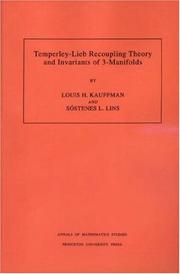
ISBN: 0691036411 0691036403 1400882532 9780691036403 9780691036410 Year: 2016 Volume: 134 Publisher: Princeton, NJ : Princeton University Press,
Abstract | Keywords | Export | Availability | Bookmark
 Loading...
Loading...Choose an application
- Reference Manager
- EndNote
- RefWorks (Direct export to RefWorks)
This book offers a self-contained account of the 3-manifold invariants arising from the original Jones polynomial. These are the Witten-Reshetikhin-Turaev and the Turaev-Viro invariants. Starting from the Kauffman bracket model for the Jones polynomial and the diagrammatic Temperley-Lieb algebra, higher-order polynomial invariants of links are constructed and combined to form the 3-manifold invariants. The methods in this book are based on a recoupling theory for the Temperley-Lieb algebra. This recoupling theory is a q-deformation of the SU(2) spin networks of Roger Penrose. The recoupling theory is developed in a purely combinatorial and elementary manner. Calculations are based on a reformulation of the Kirillov-Reshetikhin shadow world, leading to expressions for all the invariants in terms of state summations on 2-cell complexes. Extensive tables of the invariants are included. Manifolds in these tables are recognized by surgery presentations and by means of 3-gems (graph encoded 3-manifolds) in an approach pioneered by Sostenes Lins. The appendices include information about gems, examples of distinct manifolds with the same invariants, and applications to the Turaev-Viro invariant and to the Crane-Yetter invariant of 4-manifolds.
Drie-menigvuldigheden (Topologie) --- Knopentheorie --- Knot theory --- Noeuds [Theorie des ] --- Three-manifolds (Topology) --- Trois-variétés (Topologie) --- Knot theory. --- Algebraic topology --- Invariants --- Mathematics --- Invariants (Mathematics) --- Invariants. --- 3-manifolds (Topology) --- Manifolds, Three dimensional (Topology) --- Three-dimensional manifolds (Topology) --- Low-dimensional topology --- Topological manifolds --- Knots (Topology) --- 3-manifold. --- Addition. --- Algorithm. --- Ambient isotopy. --- Axiom. --- Backslash. --- Barycentric subdivision. --- Bijection. --- Bipartite graph. --- Borromean rings. --- Boundary parallel. --- Bracket polynomial. --- Calculation. --- Canonical form. --- Cartesian product. --- Cobordism. --- Coefficient. --- Combination. --- Commutator. --- Complex conjugate. --- Computation. --- Connected component (graph theory). --- Connected sum. --- Cubic graph. --- Diagram (category theory). --- Dimension. --- Disjoint sets. --- Disjoint union. --- Elaboration. --- Embedding. --- Equation. --- Equivalence class. --- Explicit formula. --- Explicit formulae (L-function). --- Factorial. --- Fundamental group. --- Graph (discrete mathematics). --- Graph embedding. --- Handlebody. --- Homeomorphism. --- Homology (mathematics). --- Identity element. --- Intersection form (4-manifold). --- Inverse function. --- Jones polynomial. --- Kirby calculus. --- Line segment. --- Linear independence. --- Matching (graph theory). --- Mathematical physics. --- Mathematical proof. --- Mathematics. --- Maxima and minima. --- Monograph. --- Natural number. --- Network theory. --- Notation. --- Numerical analysis. --- Orientability. --- Orthogonality. --- Pairing. --- Pairwise. --- Parametrization. --- Parity (mathematics). --- Partition function (mathematics). --- Permutation. --- Poincaré conjecture. --- Polyhedron. --- Quantum group. --- Quantum invariant. --- Recoupling. --- Recursion. --- Reidemeister move. --- Result. --- Roger Penrose. --- Root of unity. --- Scientific notation. --- Sequence. --- Significant figures. --- Simultaneous equations. --- Smoothing. --- Special case. --- Sphere. --- Spin network. --- Summation. --- Symmetric group. --- Tetrahedron. --- The Geometry Center. --- Theorem. --- Theory. --- Three-dimensional space (mathematics). --- Time complexity. --- Tubular neighborhood. --- Two-dimensional space. --- Vector field. --- Vector space. --- Vertex (graph theory). --- Winding number. --- Writhe.
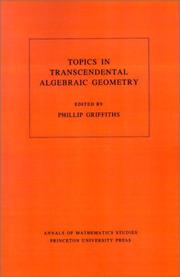
ISBN: 0691083355 0691083398 140088165X Year: 1984 Publisher: Princeton (N.J.): Princeton university press
Abstract | Keywords | Export | Availability | Bookmark
 Loading...
Loading...Choose an application
- Reference Manager
- EndNote
- RefWorks (Direct export to RefWorks)
The description for this book, Topics in Transcendental Algebraic Geometry. (AM-106), Volume 106, will be forthcoming.
Geometry, Algebraic. --- Hodge theory. --- Torelli theorem. --- Géométrie algébrique --- Théorie de Hodge --- Geometry, Algebraic --- Hodge theory --- Torelli theorem --- 512.7 --- Torelli's theorem --- Curves, Algebraic --- Jacobians --- Complex manifolds --- Differentiable manifolds --- Homology theory --- Algebraic geometry --- Geometry --- Algebraic geometry. Commutative rings and algebras --- 512.7 Algebraic geometry. Commutative rings and algebras --- Géométrie algébrique --- Théorie de Hodge --- Abelian integral. --- Algebraic curve. --- Algebraic cycle. --- Algebraic equation. --- Algebraic geometry. --- Algebraic integer. --- Algebraic structure. --- Algebraic surface. --- Arithmetic genus. --- Arithmetic group. --- Asymptotic analysis. --- Automorphism. --- Base change. --- Bilinear form. --- Bilinear map. --- Cohomology. --- Combinatorics. --- Commutative diagram. --- Compactification (mathematics). --- Complete intersection. --- Complex manifold. --- Complex number. --- Computation. --- Deformation theory. --- Degeneracy (mathematics). --- Differentiable manifold. --- Dimension (vector space). --- Divisor (algebraic geometry). --- Divisor. --- Elliptic curve. --- Elliptic surface. --- Equation. --- Exact sequence. --- Fiber bundle. --- Function (mathematics). --- Fundamental class. --- Geometric genus. --- Geometry. --- Hermitian symmetric space. --- Hodge structure. --- Homology (mathematics). --- Homomorphism. --- Homotopy. --- Hypersurface. --- Intersection form (4-manifold). --- Intersection number. --- Irreducibility (mathematics). --- Isomorphism class. --- Jacobian variety. --- K3 surface. --- Kodaira dimension. --- Kronecker's theorem. --- Kummer surface. --- Kähler manifold. --- Lie algebra bundle. --- Lie algebra. --- Linear algebra. --- Linear algebraic group. --- Line–line intersection. --- Mathematical induction. --- Mathematical proof. --- Mathematics. --- Modular arithmetic. --- Module (mathematics). --- Moduli space. --- Monodromy matrix. --- Monodromy theorem. --- Monodromy. --- Nilpotent orbit. --- Normal function. --- Open set. --- Period mapping. --- Permutation group. --- Phillip Griffiths. --- Point at infinity. --- Pole (complex analysis). --- Polynomial. --- Projective space. --- Pullback (category theory). --- Quadric. --- Regular singular point. --- Resolution of singularities. --- Riemann–Roch theorem for surfaces. --- Scientific notation. --- Set (mathematics). --- Special case. --- Spectral sequence. --- Subgroup. --- Submanifold. --- Surface of general type. --- Surjective function. --- Tangent bundle. --- Theorem. --- Topology. --- Transcendental number. --- Vector space. --- Zariski topology. --- Zariski's main theorem.
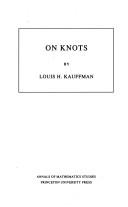
ISBN: 0691084343 0691084351 1400882133 9780691084343 Year: 1987 Volume: 115 Publisher: Princeton : Princeton University Press,
Abstract | Keywords | Export | Availability | Bookmark
 Loading...
Loading...Choose an application
- Reference Manager
- EndNote
- RefWorks (Direct export to RefWorks)
On Knots is a journey through the theory of knots, starting from the simplest combinatorial ideas--ideas arising from the representation of weaving patterns. From this beginning, topological invariants are constructed directly: first linking numbers, then the Conway polynomial and skein theory. This paves the way for later discussion of the recently discovered Jones and generalized polynomials. The central chapter, Chapter Six, is a miscellany of topics and recreations. Here the reader will find the quaternions and the belt trick, a devilish rope trick, Alhambra mosaics, Fibonacci trees, the topology of DNA, and the author's geometric interpretation of the generalized Jones Polynomial.Then come branched covering spaces, the Alexander polynomial, signature theorems, the work of Casson and Gordon on slice knots, and a chapter on knots and algebraic singularities.The book concludes with an appendix about generalized polynomials.
Knot theory --- Knots (Topology) --- Low-dimensional topology --- Knot theory. --- Algebraic topology --- 3-sphere. --- Addition theorem. --- Addition. --- Alexander polynomial. --- Algebraic variety. --- Algorithm. --- Ambient isotopy. --- Arf invariant. --- Basepoint. --- Bijection. --- Bilinear form. --- Borromean rings. --- Bracket polynomial. --- Braid group. --- Branched covering. --- Chiral knot. --- Chromatic polynomial. --- Cobordism. --- Codimension. --- Combination. --- Combinatorics. --- Complex analysis. --- Concentric. --- Conjecture. --- Connected sum. --- Conway polynomial (finite fields). --- Counting. --- Covering space. --- Cyclic group. --- Dense set. --- Determinant. --- Diagram (category theory). --- Diffeomorphism. --- Dimension. --- Disjoint union. --- Disk (mathematics). --- Dual graph. --- Elementary algebra. --- Embedding. --- Enumeration. --- Existential quantification. --- Exotic sphere. --- Fibration. --- Formal power series. --- Fundamental group. --- Geometric topology. --- Geometry and topology. --- Geometry. --- Group action. --- Homotopy. --- Integer. --- Intersection form (4-manifold). --- Isolated singularity. --- Jones polynomial. --- Knot complement. --- Knot group. --- Laws of Form. --- Lens space. --- Linking number. --- Manifold. --- Module (mathematics). --- Morwen Thistlethwaite. --- Normal bundle. --- Notation. --- Obstruction theory. --- Operator algebra. --- Pairing. --- Parity (mathematics). --- Partition function (mathematics). --- Planar graph. --- Point at infinity. --- Polynomial ring. --- Polynomial. --- Quantity. --- Rectangle. --- Reidemeister move. --- Remainder. --- Root of unity. --- Saddle point. --- Seifert surface. --- Singularity theory. --- Slice knot. --- Special case. --- Statistical mechanics. --- Substructure. --- Summation. --- Symmetry. --- Theorem. --- Three-dimensional space (mathematics). --- Topological space. --- Torus knot. --- Trefoil knot. --- Tubular neighborhood. --- Underpinning. --- Unknot. --- Variable (mathematics). --- Whitehead link. --- Wild knot. --- Writhe. --- Variétés topologiques --- Topologie combinatoire --- Theorie des noeuds
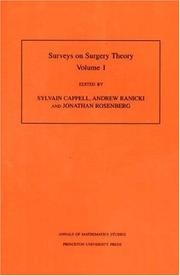

ISBN: 0691049386 0691088152 1322055211 1400865190 0691049378 1322063281 1400865212 0691088144 9781400865192 9780691049380 9780691049373 9781400865215 9780691088150 9780691088150 9780691088143 Year: 2014 Volume: 145,149 Publisher: Princeton, NJ
Abstract | Keywords | Export | Availability | Bookmark
 Loading...
Loading...Choose an application
- Reference Manager
- EndNote
- RefWorks (Direct export to RefWorks)
Surgery theory, the basis for the classification theory of manifolds, is now about forty years old. The sixtieth birthday (on December 14, 1996) of C.T.C. Wall, a leading member of the subject's founding generation, led the editors of this volume to reflect on the extraordinary accomplishments of surgery theory as well as its current enormously varied interactions with algebra, analysis, and geometry. Workers in many of these areas have often lamented the lack of a single source surveying surgery theory and its applications. Because no one person could write such a survey, the editors asked a variety of experts to report on the areas of current interest. This is the second of two volumes resulting from that collective effort. It will be useful to topologists, to other interested researchers, and to advanced students. The topics covered include current applications of surgery, Wall's finiteness obstruction, algebraic surgery, automorphisms and embeddings of manifolds, surgery theoretic methods for the study of group actions and stratified spaces, metrics of positive scalar curvature, and surgery in dimension four. In addition to the editors, the contributors are S. Ferry, M. Weiss, B. Williams, T. Goodwillie, J. Klein, S. Weinberger, B. Hughes, S. Stolz, R. Kirby, L. Taylor, and F. Quinn.
Chirurgie (Topologie) --- Heelkunde (Topologie) --- Surgery (Topology) --- Differential topology --- Homotopy equivalences --- Manifolds (Mathematics) --- Topology --- Algebraic topology (object). --- Algebraic topology. --- Ambient isotopy. --- Assembly map. --- Atiyah–Hirzebruch spectral sequence. --- Atiyah–Singer index theorem. --- Automorphism. --- Banach algebra. --- Borsuk–Ulam theorem. --- C*-algebra. --- CW complex. --- Calculation. --- Category of manifolds. --- Characterization (mathematics). --- Chern class. --- Cobordism. --- Codimension. --- Cohomology. --- Compactification (mathematics). --- Conjecture. --- Contact geometry. --- Degeneracy (mathematics). --- Diagram (category theory). --- Diffeomorphism. --- Differentiable manifold. --- Differential geometry. --- Dirac operator. --- Disk (mathematics). --- Donaldson theory. --- Duality (mathematics). --- Embedding. --- Epimorphism. --- Excision theorem. --- Exponential map (Riemannian geometry). --- Fiber bundle. --- Fibration. --- Fundamental group. --- Group action. --- Group homomorphism. --- H-cobordism. --- Handle decomposition. --- Handlebody. --- Homeomorphism group. --- Homeomorphism. --- Homology (mathematics). --- Homomorphism. --- Homotopy extension property. --- Homotopy fiber. --- Homotopy group. --- Homotopy. --- Hypersurface. --- Intersection form (4-manifold). --- Intersection homology. --- Isomorphism class. --- K3 surface. --- L-theory. --- Limit (category theory). --- Manifold. --- Mapping cone (homological algebra). --- Mapping cylinder. --- Mostow rigidity theorem. --- Orthonormal basis. --- Parallelizable manifold. --- Poincaré conjecture. --- Product metric. --- Projection (linear algebra). --- Pushout (category theory). --- Quaternionic projective space. --- Quotient space (topology). --- Resolution of singularities. --- Ricci curvature. --- Riemann surface. --- Riemannian geometry. --- Riemannian manifold. --- Ring homomorphism. --- Scalar curvature. --- Semisimple algebra. --- Sheaf (mathematics). --- Sign (mathematics). --- Special case. --- Sub"ient. --- Subgroup. --- Submanifold. --- Support (mathematics). --- Surgery exact sequence. --- Surgery obstruction. --- Surgery theory. --- Symplectic geometry. --- Symplectic vector space. --- Theorem. --- Topological conjugacy. --- Topological manifold. --- Topology. --- Transversality (mathematics). --- Transversality theorem. --- Vector bundle. --- Waldhausen category. --- Whitehead torsion. --- Whitney embedding theorem. --- Yamabe invariant.
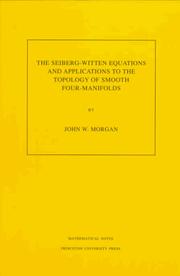
ISBN: 1400865166 9781400865161 9780691025971 0691025975 9780691025971 Year: 2014 Publisher: Princeton, NJ
Abstract | Keywords | Export | Availability | Bookmark
 Loading...
Loading...Choose an application
- Reference Manager
- EndNote
- RefWorks (Direct export to RefWorks)
The recent introduction of the Seiberg-Witten invariants of smooth four-manifolds has revolutionized the study of those manifolds. The invariants are gauge-theoretic in nature and are close cousins of the much-studied SU(2)-invariants defined over fifteen years ago by Donaldson. On a practical level, the new invariants have proved to be more powerful and have led to a vast generalization of earlier results. This book is an introduction to the Seiberg-Witten invariants. The work begins with a review of the classical material on Spin c structures and their associated Dirac operators. Next comes a discussion of the Seiberg-Witten equations, which is set in the context of nonlinear elliptic operators on an appropriate infinite dimensional space of configurations. It is demonstrated that the space of solutions to these equations, called the Seiberg-Witten moduli space, is finite dimensional, and its dimension is then computed. In contrast to the SU(2)-case, the Seiberg-Witten moduli spaces are shown to be compact. The Seiberg-Witten invariant is then essentially the homology class in the space of configurations represented by the Seiberg-Witten moduli space. The last chapter gives a flavor for the applications of these new invariants by computing the invariants for most Kahler surfaces and then deriving some basic toological consequences for these surfaces.
Four-manifolds (Topology) --- Seiberg-Witten invariants. --- Mathematical physics. --- Physical mathematics --- Physics --- Invariants --- 4-dimensional manifolds (Topology) --- 4-manifolds (Topology) --- Four dimensional manifolds (Topology) --- Manifolds, Four dimensional --- Low-dimensional topology --- Topological manifolds --- Mathematics --- Affine space. --- Affine transformation. --- Algebra bundle. --- Algebraic surface. --- Almost complex manifold. --- Automorphism. --- Banach space. --- Clifford algebra. --- Cohomology. --- Cokernel. --- Complex dimension. --- Complex manifold. --- Complex plane. --- Complex projective space. --- Complex vector bundle. --- Complexification (Lie group). --- Computation. --- Configuration space. --- Conjugate transpose. --- Covariant derivative. --- Curvature form. --- Curvature. --- Differentiable manifold. --- Differential topology. --- Dimension (vector space). --- Dirac equation. --- Dirac operator. --- Division algebra. --- Donaldson theory. --- Duality (mathematics). --- Eigenvalues and eigenvectors. --- Elliptic operator. --- Elliptic surface. --- Equation. --- Fiber bundle. --- Frenet–Serret formulas. --- Gauge fixing. --- Gauge theory. --- Gaussian curvature. --- Geometry. --- Group homomorphism. --- Hilbert space. --- Hodge index theorem. --- Homology (mathematics). --- Homotopy. --- Identity (mathematics). --- Implicit function theorem. --- Intersection form (4-manifold). --- Inverse function theorem. --- Isomorphism class. --- K3 surface. --- Kähler manifold. --- Levi-Civita connection. --- Lie algebra. --- Line bundle. --- Linear map. --- Linear space (geometry). --- Linearization. --- Manifold. --- Mathematical induction. --- Moduli space. --- Multiplication theorem. --- Neighbourhood (mathematics). --- One-form. --- Open set. --- Orientability. --- Orthonormal basis. --- Parameter space. --- Parametric equation. --- Parity (mathematics). --- Partial derivative. --- Principal bundle. --- Projection (linear algebra). --- Pullback (category theory). --- Quadratic form. --- Quaternion algebra. --- Quotient space (topology). --- Riemann surface. --- Riemannian manifold. --- Sard's theorem. --- Sign (mathematics). --- Sobolev space. --- Spin group. --- Spin representation. --- Spin structure. --- Spinor field. --- Subgroup. --- Submanifold. --- Surjective function. --- Symplectic geometry. --- Symplectic manifold. --- Tangent bundle. --- Tangent space. --- Tensor product. --- Theorem. --- Three-dimensional space (mathematics). --- Trace (linear algebra). --- Transversality (mathematics). --- Two-form. --- Zariski tangent space.
| Listing 1 - 10 of 13 | << page >> |
Sort by
|

 Search
Search Feedback
Feedback About UniCat
About UniCat  Help
Help News
News